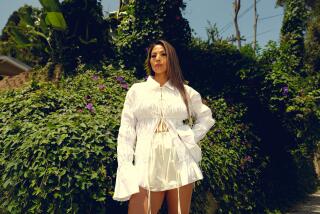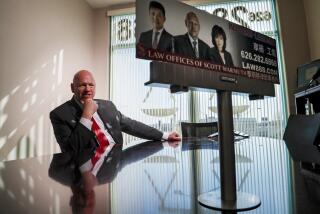Agencies Find Images From Land Down Under Work Well--to a Point
- Share via
One executive took a liking to the name G’Day Springs. Another thought the product should be called Boomerang. The name Kangaroo Springs was given a go-round. And at one point, the company’s top officials all but settled on Bonzer--a slang Australian term for terrific.
All those names went out the door, however, when some focus groups went gaga over Wallaroo. That’s right, Wallaroo. If you don’t know a wallaroo from a cockatoo, don’t worry. Neither do most folks. But it sounded “very Australian” to groups of consumers.
“They’d never heard the word before,” said John Flocken, senior product marketing manager at Sparkletts Grocery Products Co., the Los Angeles subsidiary of San Francisco-based McKesson Corp. that is importing Wallaroo sparkling water in a partnership with Amatil Ltd., Australia’s largest bottled water company. “But people in the focus groups said they could still relate to wallaroo.” After all, it sounded like kangaroo. And, indeed, a wallaroo is an honest-to-gosh marsupial that is part wallaby and part kangaroo.
For several years, advertisements with Australian imagery have been big sellers in America. Put a cuddly koala bear or an equally cuddly shot of actor Paul Hogan on the screen, and Americans will eagerly buy just about anything they sell.
But these Aussie images already appear to be victims of their success. For one thing, some companies that have only the remotest of Australian connections are trying to cash in by adopting Aussie images for their products. And executives from the ad agencies that created these campaigns concede that American audiences will now accept only a handful of the same tired images--such as kangaroos hopping and boomerangs flying--as being authentically Australian.
“As far as many Americans are concerned,” said Mike Strauss, newly named chairman and chief executive of the West Pacific Region of the New York ad agency D’Arcy Masius Benton & Bowles, “when they visit Australia, they expect to see koala bears and kangaroos hopping down Main Street.”
The basic problem is that the stereotypes work too well. “In an ideal world, we wouldn’t keep using these stereotypes,” said Bob Hoffman, chief executive of the San Francisco office of the Australian ad firm Mojo MDA, which makes those koala bear ads for Qantas Airlines and whose parent company in Sydney created the Paul Hogan ads for the Australian Tourist Commission. “But many of these images sell products. You know, like the Englishman who carries an umbrella and the American who wears a cowboy hat.”
Now, of course, there’s the outback Aussie who slips shrimps on the barbie. “There may be no perfect spokesman,” said Bill Baker, manager of the Australian Tourist Commission’s Western USA division, “but Paul Hogan projects the image of the quintessential Australian.”
Not to everyone. When some Australian government officials and industry leaders first saw the Hogan campaign, their reaction was, “Oh my God, he’s representing us?” said Edward R. Bennett, senior vice president at Mojo in San Francisco. In Australia, some people regard Hogan as an “ocker”--sort of a back woodsman with a minimal education. “But the fact is,” Bennett said, “the American people have embraced him.”
The two Crocodile Dundee films that Hogan stars in have grossed more than $500 million. And since his Aussie ad campaign was introduced five years ago, the number of Americans visiting Australia annually has more than tripled.
But Hogan has not filmed an ad for the tourism commission in more than two years. Hogan, who was unavailable for comment, stated recently that he did not want to appear in any more advertisements. But Baker at the tourism commission says his group continues to have “ongoing discussions” with Hogan’s representatives.
No matter what anyone says, the image that was created still works--even for non-Aussie products. A year-old wine cooler, Matilda Bay, has used Hogan-like characters in several commercials. And with good reason.
Early on, Miller Brewing Co., which makes Matilda Bay, was considering a theme that had nothing to do with Australia. In fact, it ran ads in the Atlanta and Kansas City areas that positioned Matilda Bay as more of a tropical wine cooler. The ads showed scenes of exotic dancers with flowers in their hair. At the same time, however, ads in the Denver and San Diego markets pictured Hogan-like characters tossing boomerangs while enjoying the beverage. “The focus groups all told us, hands down, they liked the Crocodile Dundee look,” said Beverly Jurkowski, public relations manager for Matilda Bay.
As for the name Matilda Bay, well, that’s another story. You won’t find a Matilda Bay in Australia. The name was concocted simply to sound Australian. Of course, if the American public tires of the Australian imagery, the company is prepared to quickly change the scenery. “I suppose,” said Jurkowski, “if we wanted, there could be a place called Matilda Bay off the coast of Africa or Mexico.”
Several advertisers whose products have Aussie themes have considered going beyond the stereotypes. But their own research keeps convincing them not to. The makers of Wallaroo almost settled on the name Kookaburra Springs. A kookaburra is a colorful Australian bird. “But we discovered it didn’t say Australian to anybody but Australians,” Flocken said.
Likewise, since it began using the koala bear as its symbol 26 years ago, Qantas Airlines has considered other ad images. “Sure, we’ve had executives who have asked if he is still the best vehicle for us,” said Michael Henderson, manager of advertising. “But our research keeps proving to us that the koala is locked-in as our presenter.”
A kindergarten teacher recently confirmed this in a letter to Quantas. The teacher said she showed a picture of a koala bear to her class and asked them to identify it. Said one little boy: “That’s a Qantas.”
Agency Pins Hopes on State Lawmakers
What do you do when an $8-million client is eliminated by the state Legislature?
Well, if you’re the Los Angeles ad firm Keye/Donna/Pearlstein, you hope the Legislature changes its mind. Last week, however, state officials voted to cut off all funding for the California Office of Tourism. Those funds, however could be reinstated when the Legislature meets again in August.
In the meantime, the ad agency continues to create ads for the tourism group, said Leonard Pearlstein, president and chief executive of Keye/Donna/Pearlstein. “We’re still working away,” said Pearlstein, whose agency has created the commission’s ads for three years. Although Pearlstein said losing the account would not result in layoffs at his agency, “It wouldn’t make us happy campers.”
Luckiest People to Get Own Special Magazine
People magazine has decided that the rich are, indeed, different. As a result, in October wealthy subscribers will begin to receive special issues of the magazine that are filled with ads targeted at them.
This group, however, wasn’t selected by zip code, says Eric Thorkilsen, associate publisher of People. Instead, so-called big spenders editions of the magazine will be sent to 250,000 subscribers who meet two criterion: They must own their homes and have annual household incomes exceeding $50,000.
The magazine finds out these income figures from databases that it purchases from private companies, a spokeswoman said. People then matches those names with its own subscribers. Perhaps, the luckiest People in the world?
More to Read
Inside the business of entertainment
The Wide Shot brings you news, analysis and insights on everything from streaming wars to production — and what it all means for the future.
You may occasionally receive promotional content from the Los Angeles Times.










